Bacterial Cell Culture Market Research, 2031
The global bacterial cell culture market size was valued at $2.8 billion in 2021, and is projected to reach $5.2 billion by 2031, growing at a CAGR of 6.3% from 2022 to 2031. Bacterial cell culture is practiced on a large scale around the globe due to the multiple purposes and applications in the healthcare sector and life science sector. It has a vast application in the development and manufacturing of biopharmaceuticals in the pharmaceuticals industry. In the recent years there has been a large growth in the biotechnology sector owing to rise in knowledge about the field and its broad spectrum of application. In addition, the market players are focusing on developing sustainable and natural products leading to demand for bacterial cell culture techniques.
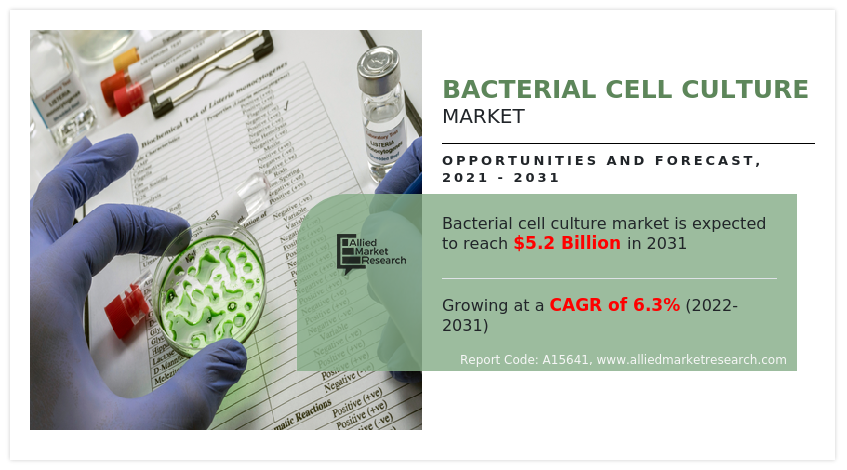
Furthermore, the bacterial cell culture is used in the diagnosis of various diseases, in food and water testing, in agricultural sector, animal feed, and others. According to the Centers of Disease Control and Prevention (CDC), strep throat causes an estimated 5.2 million outpatient visits and 2.8 million antibiotic prescriptions annually among the U.S. population aged 0 to 64 years. Thus, this shows the prevalence of the infectious diseases caused by various bacteria including group A streptococcus, escherichia coli, and others which highlights the need for their appropriate diagnosis and treatment. Thus, propelling the growth during bacterial cell culture market forecastas a diagnostic aid.
The increase in adoption of bacterial cell culture for food testing, rise in usage of bacterial cell culture in animal feed, and increase in adoption of bacterial cell culture techniques in biopharmaceuticals are the drivers propelling the bacterial cell culture market growth. Moreover, increase in healthcare expenditure and technological advancements in the biotechnology field are the factors proving lucrative opportunities for market players for investments, thereby propelling the growth of the bacterial cell culture market share. These drivers provide a favorable environment for increasing the sales of the products and also for the growth of the overall bacterial cell culture market size.
However, the market may be somewhat constrained throughout the anticipated period due to lack of skilled professionals for handling these advanced healthcare infrastructure as well as the high investment associated with the research and development.
Impact of COVID-19 on bacterial cell culture market
Coronavirus severe acute respiration syndrome (SARS-CoV-2) is an infectious disease caused by the novel coronavirus (COVID-19), which originated in the Wuhan district in China in the late 2019, and since has spread to 212 countries. WHO declared COVID-19 as a pandemic on March 11, 2020, and by September 21, 2022, over 613 million people have been infected globally with over 65.3 lakhs deaths. COVID-19 symptoms include fever, cough, and shortness of breath. In January 2021, the DCGI announced approval of COVAXIN for emergency use to prevent COVID-19. Meanwhile, in January 2021, AstraZeneca, a global biopharmaceutical company, announced approval of AstraZeneca COVID-19 vaccine for prevention of COVID-19.
The COVID-19 outbreak is anticipated to have a positive impact on growth of the global bacterial cell culture market, as these cultures are utilized in the diagnostic purposes and assist in detection of various diseases. Additionally, there was a surge in the research studies during the pandemic for the sake of developing treatment options for the symptoms related to COVID-19. Furthermore, the development of the vaccination lead to the rise in the demand for the culture media and associated equipment. In addition, increase in the cases of COVID-19 has raised the need of vaccines which resulted in many research and development leading to increase in clinical trials and thereby raising the demand for bacterial cell culture products. In addition, regularization of supply chain of medications by key players and rise in the number of patient visits for investigation and treatment is anticipated to fuel the growth of the market after COVID-19 pandemic.
The bacterial cell culture market is segmented on the basis of product type, application, end user, and region. As per product type, it is classified into media, reagents, and sera. On the basis of application, it is segmented into disease diagnosis, food testing, water testing, and others. According to end user, it is divided into diagnostic centers, food industry, and others.
Region wise, the market is analyzed across North America (the U.S., Canada, and Mexico), Europe (Germany, France, UK, Italy, Spain, and rest of Europe), Asia-Pacific (Japan, China, Australia, India, South Korea, and rest of Asia-Pacific), and LAMEA (Brazil, Saudi Arabia, South Africa, and rest of LAMEA).
Segment Review
On the basis of product type, the media segment registered the largest revenue for the year 2021, and is expected to grow at a highest CAGR during the forecast period owing to the rise in investment by key market players to manufacture the media and other associated products to meet the rising demand in the biotechnological companies.
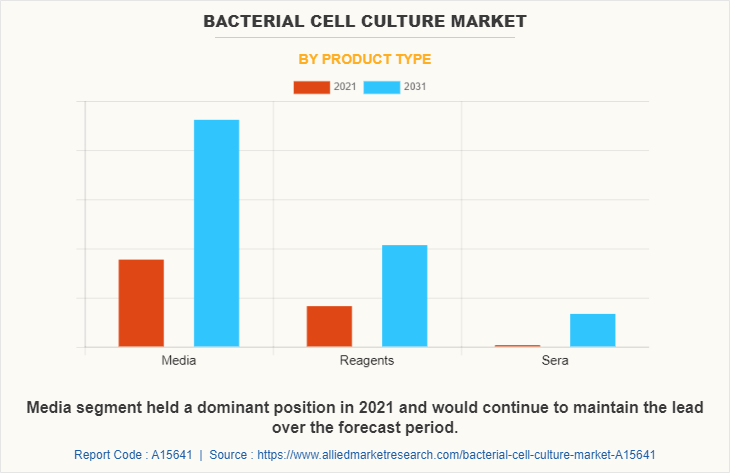
By application, the food testing segment exhibited the highest revenue in 2021, due to the rise in food poisoning cases around the globe and increase in awareness about food testing and food safety. On the other hand, the disease diagnosis segment is expected to grow at the fastest CAGR during the forecast period, owing to prevalence of infectious diseases such as urinary tract infections, throat infections, and others.
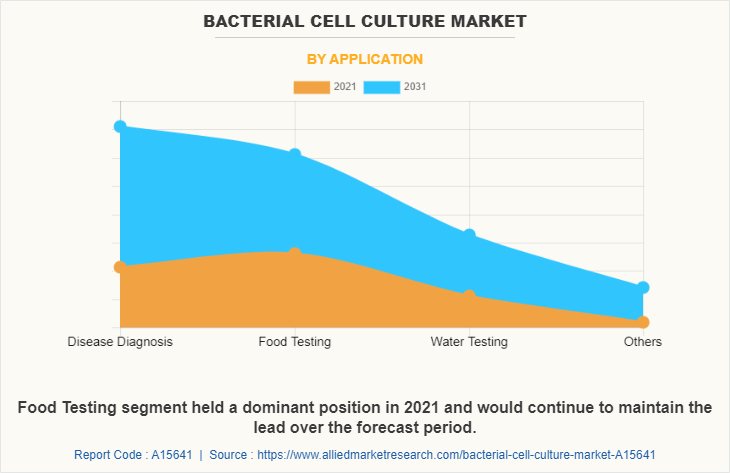
By end user, the others segment held the largest share of the bacterial cell culture market in 2021 and is expected to grow at the fastest CAGR during the forecast period, which is mainly driven by rise in the funding offered by the government and private organizations which empowers the public and private key players to carry out R&D on a large scale and thereby leading to rise in number of product approvals and launching.
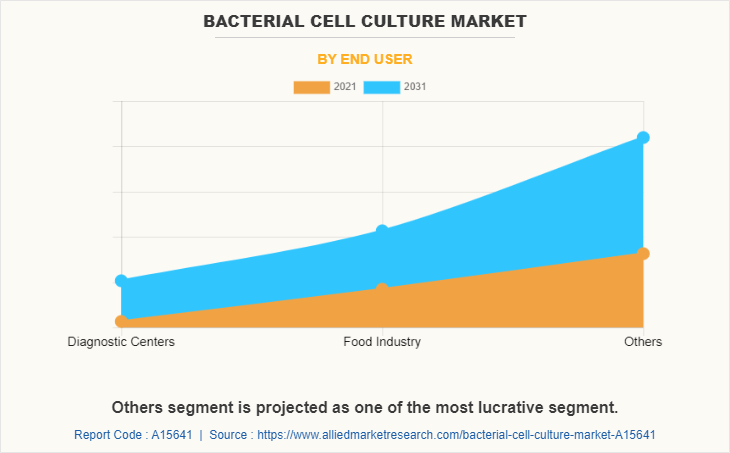
Region wise, North America acquired a major share, owing to the increase in prevalence of food poisoning cases in North America, availability of different advanced diagnosis and treatment options, development of animal-component free media, presence of automated cell culture systems, and presence of key players leading to the growth of the bacterial cell culture market. However, Asia-Pacific is expected to witness the highest rate of CAGR for the bacterial cell culture market during the forecast period.
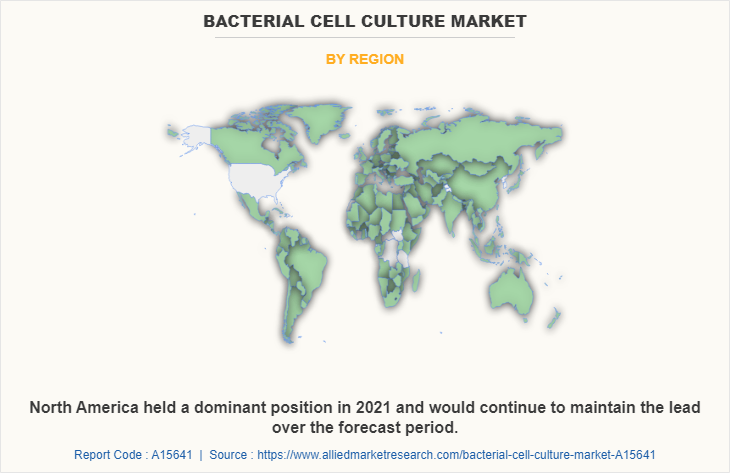
Some of the major companies that operate in the global bacterial cell culture industry are bioMerieux SA, Bio-Rad Laboratories, Inc., Boekel Scientific, Danaher Corporation (Cytiva), Eiken Chemical Co., Ltd., HiMedia Laboratories Pvt. Ltd., Merck KGaA, Neogen Corporation, ScienCell Research Laboratories, Inc., and Thermo Fisher Scientific Inc. among others.
Key Benefits For Stakeholders
- This report provides a quantitative analysis of the market segments, current trends, estimations, and dynamics of the bacterial cell culture market analysis from 2021 to 2031 to identify the prevailing bacterial cell culture market opportunity.
- The market research is offered along with information related to key drivers, restraints, and opportunities.
- Porter's five forces analysis highlights the potency of buyers and suppliers to enable stakeholders make profit-oriented business decisions and strengthen their supplier-buyer network.
- In-depth analysis of the bacterial cell culture market segmentation assists to determine the prevailing market opportunities.
- Major countries in each region are mapped according to their revenue contribution to the global market.
- Market player positioning facilitates benchmarking and provides a clear understanding of the present position of the market players.
- The report includes the analysis of the regional as well as global bacterial cell culture market trends, key players, market segments, application areas, and market growth strategies.
Bacterial Cell Culture Market Report Highlights
| Aspects | Details |
| Market Size By 2031 | USD 5.2 billion |
| Growth Rate | CAGR of 6.3% |
| Forecast period | 2021 - 2031 |
| Report Pages | 273 |
| By Product Type |
|
| By Application |
|
| By End user |
|
| By Region |
|
| Key Market Players | ScienCell Research Laboratories, Inc., Bio-Rad Laboratories, Inc., BioMérieux S.A., Hi-Media Laboratories Pvt. Ltd., Neogen Corporation, Biokel Scientific, Thermo Fisher Scientific, Inc., Danaher Corporation, EMD (Merck) Millipore, Eiken Chemical Co, Ltd. |
Analyst Review
This section provides the opinions of the top-level CXOs operating in the global bacterial cell culture market. According to the insights of the CXOs, the global bacterial cell culture market is expected to exhibit high growth potential attributable to factors such as rise in R&D activities in pharmaceutical and biotechnological industries for developing advanced healthcare techniques, increase in prevalence of infectious diseases, and surge in number of advancements in diagnosis and treatment. Furthermore, the bacterial cell culture market has gained the interest of many pharmaceutical and biotechnological companies, owing to surge in demand for healthcare facilities due to rise in patient pool in the regions such as Asia-Pacific and LAMEA. Moreover, increase in number of food and water borne diseases, which leads to bacterial infections in humans and requires food and water testing, notably contributes toward the growth of the market.
The CXOs further added that North America is expected to witness the highest growth, in terms of revenue, owing to the presence of key players, rising government initiatives, well-developed healthcare infrastructure, and rising prevalence of health issues and Asia-Pacific is expected to register highest growth during the forecast period, owing to the presence of key private and public players manufacturing bacterial cell culture products in this region.
Increase in healthcare expenditure and technological advancements in the biotechnology field are the factors proving lucrative opportunities for market.
Some of the major companies that operate in the global bacterial cell culture market are bioMerieux SA, Bio-Rad Laboratories, Inc., Boekel Scientific, Danaher Corporation (Cytiva), Eiken Chemical Co., Ltd., HiMedia Laboratories Pvt. Ltd., Merck KGaA, Neogen Corporation, ScienCell Research Laboratories, Inc., and Thermo Fisher Scientific Inc.
North America is the largest regional market for Bacterial Cell Culture
Bacterial Cell Culture is projected to reach $5,177.67 million by 2031, registering a CAGR of 6.3% from 2022 to 2031.
Food testing segment exhibited the highest revenue in 2021
The base year is 2021 in Bacterial Cell Culture market
Yes, the Bacterial Cell Culture market report provides PORTER Analysis
Loading Table Of Content...


